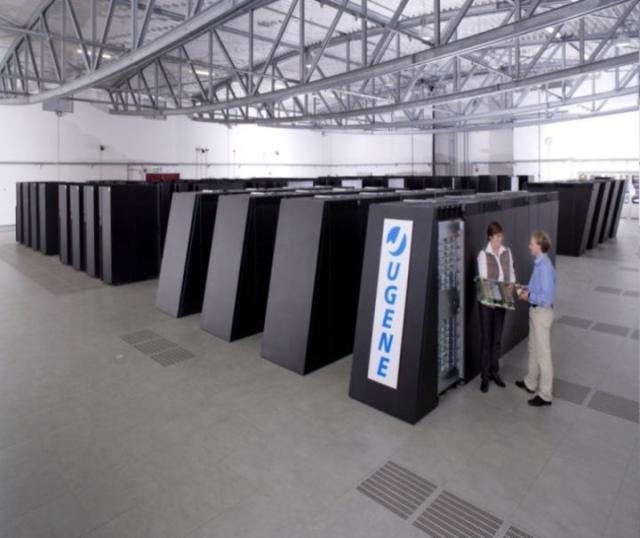Jun 29 2016
Physicists from the Skobeltsyn Institute of Nuclear Physics, the Lomonosov Moscow State University, have learned to utilize personal computers for calculating complex quantum mechanics equations, which are usually solved only with the assistance of supercomputers. This PC could perform the job much more rapidly. These findings have been reported in the journal Computer Physics Communications.
 Jugene (Jülich Blue Gene) - a supercomputer built by IBM for Forschungszentrum Jülich in Germany. (Credit - Vladimir Kukulin)
Jugene (Jülich Blue Gene) - a supercomputer built by IBM for Forschungszentrum Jülich in Germany. (Credit - Vladimir Kukulin)
Under the guidance of Professor Vladimir Kukulin (SINP MSU), both Vladimir Pomerantcev and Olga Rubtsova, senior scientists, were able to solve complex integral quantum mechanics equations using common desktop PC with GPU. These equations were earlier solved only with powerful, costly supercomputers. Vladimir Kukulin said that the personal computer could do the job much quicker, and that within 15 minutes it can do the work that the supercomputers usually do for a period of 2-3 days.
Ludwig Faddeev, a Russian mathematician formulated the equations in question in the 1960s. The equations explain the scattering of some quantum particles. It represents a quantum mechanical analog of the Newtonian theory for the three body systems. The entire field of quantum mechanics referred to as "physics of few-body systems" emerged immediately after this.
This area can be of enormous significance to researchers working on nuclear and atomic physics, quantum mechanics, and the theory of scattering. After the revolutionary work of Faddeev, for a number of years one of their major intentions was to comprehend these complex equations. However, the incredible difficulty of the calculations in fully realistic interactions between the particles of a system was out of reach of the scientists for very long, until the arrival of supercomputers.
The condition changed after the group of SINP started using one of the newly designed Nvidia GPs for use in game consoles on their PC. One of the authors, Vladimir Kukulin, Head of Laboratory of Nuclear Theory, said that the processor was not the most costly, among those which could be purchased for $ 300-500.
The major difficulty while working on the scattering equations of multiple quantum particles was the integral kernel calculation. Integral kernel is a huge 2D table, containing tens to hundreds of thousands of rows and columns, where every element of this matrix was the result of highly complicated calculations. This table however looked like a monitor screen having tens of billions of pixels, and using an excellent GPU all of these could be calculated. The scientists divided their calculations on the numerous streams and could solve the problem in a brilliant manner by making use of the software created in Nvidia and by writing their own programs.
We reached the speed we couldn't even dream of. The program computes 260 million of complex double integrals on a desktop computer within three seconds only. No comparison with supercomputers! My colleague from the University of Bochum in Germany (recently deceased, mournfully), whose lab did the same, carried out the calculations by one of the largest supercomputers in Germany with the famous blue gene architecture that is actually very expensive. And what his group is seeking for two or three days, we do in 15 minutes without spending a dime.
Vladimir Kukulin
The most remarkable thing is that the expected quality of the graphics processors and a vast quantity of software for them were already there for a decade, but were not used by anyone for such calculations, having a preference for supercomputers. The physicists have astonished their Western counterparts.
This work, in our opinion, opens up completely new ways to analyze nuclear and resonance chemical reactions. It can also be very useful for solving a large number of computing tasks in plasma physics, electrodynamics, geophysics, medicine and many other areas of science. We want to organize a kind of training course, where researchers from various scientific areas of peripheral universities that do not have access to supercomputers could learn to do on their PCs the same thing that we do.
Vladimir Kukulin